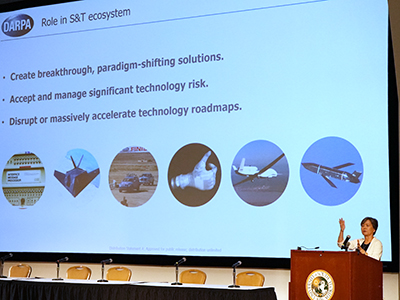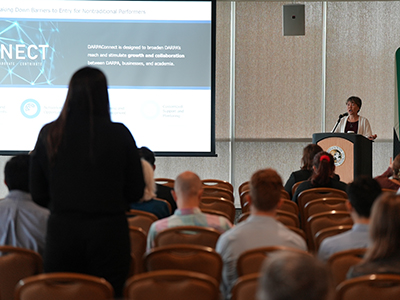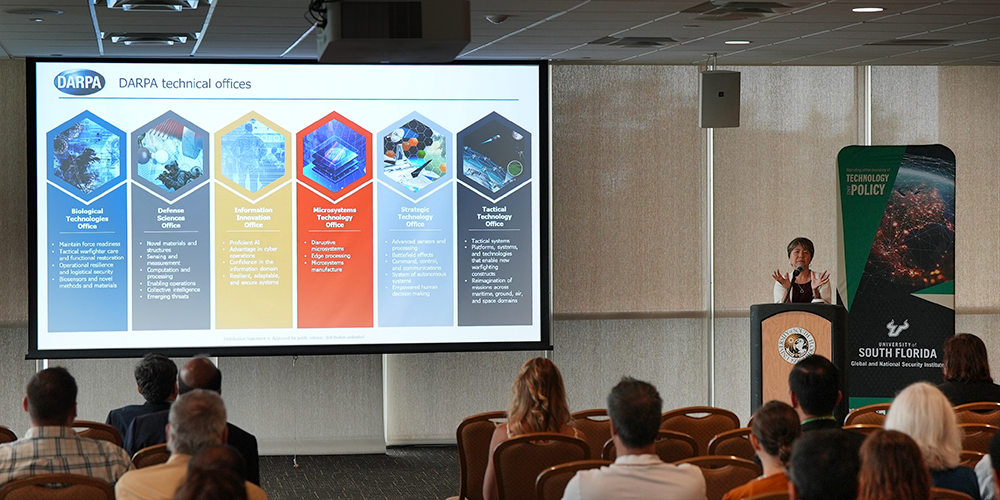The Global and National Security Institute (GNSI) had the honor of hosting Dr. Stefanie Tompkins, the director of the Defense Advanced Research Projects Agency (DARPA), during the second day of the GNSI Tampa Summit 2 held September 28, 2023 at the University of South Florida (USF). Building on the Summit’s topic of the Future and Ethics of Uncrewed and Autonomous Warfare, Tompkins' presentation was a testament to the importance of fostering collaboration between academia and agencies at the forefront of technological innovation dedicated to advancing national security.
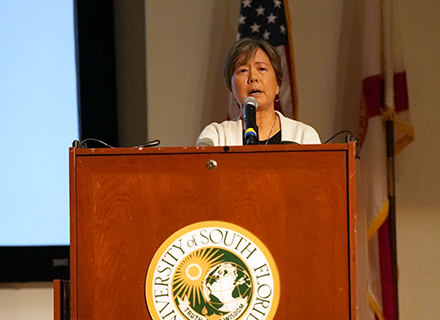
Dr. Stefanie Tompkins during her keynote address at GNSI Tampa Summit 2, September 28, 2023
During her keynote address at the Summit, Tompkins delved into ethical, societal, and legal implications associated with emerging technologies. She also provided insights into DARPA's unique approach to investing in breakthrough technologies for national security.
Tompkins opened her address by recounting DARPA's historical roots:
“We were actually founded in response to one of the biggest technological surprises our nation had ever faced, and that was the launch of the Sputnik satellite,” referring to the Soviet Union’s launch of the first artificial satellite in 1957. That event shocked America and ignited the USA-USSR space race.
Tompkins emphasized her agency operates on the principle that taking risks and looking far into the future is essential for making significant advancements:
“It’s DARPA’s job to accelerate and push it with a high-risk, high-payoff mindset, much beyond what the normal science and technology ecosystem would do.”
Furthermore, Tompkins elaborated on DARPA's approach to preventing technological surprises, emphasizing the agency's proactive approach:
“It’s DARPA’s job to accelerate and push it with a high-risk, high-payoff mindset, much beyond what the normal science and technology ecosystem would do.”
“It’s really hard to prevent surprise in the sense that we don’t have crystal balls that can predict the future, so the DARPA approach to that mission has been to always be at the bleeding edge, maybe [even] beyond that bleeding edge so that if we [are], in fact, making those technological investments into surprising OURSELVES, it makes it much more likely that we are not [victimized] by that type of surprise by others."
In addition to her keynote address at GNSI Tampa Summit 2, Tompkins made time for a series of meetings with USF faculty, students, and staff, including a “DARPA 101” presentation, hosted by GNSI. Tompkins provided USF faculty, staff, and students an inside look at DARPA – a $4 billion agency whose mission is to drive pivotal investments in breakthrough military and national security technologies. Tompkins spoke at length about the best ways for USF faculty to connect with DARPA about research opportunities. She eagerly spoke to students about careers at DARPA, encouraging them to explore all the opportunities the agency can provide.
During the DARPA 101 conversation, Tompkins answered a series of questions that shed light on DARPA's role in national security, its interest in cutting-edge university research, and its vision for the future. Let's explore her responses to these questions (some of the questions have been edited for clarity and length):
Q: What do you think will be the next game-changer that makes the jump to society as a whole?
DARPA starts about 50 new programs a year, any of which we think has the potential to make a significant impact. This question is always a bit like being asked to choose a favorite child, but I would highlight programs aimed at solving supply chain challenges, a problem known to military planners and made apparent to everyone during the pandemic. For example, we have programs focused on creating things when and where we need them – from medicine-on-demand to food and water extracted from the air.
Q: What is quantum computing? What’s DARPA’s role in its development? What potential does quantum computing have for national security?
We have a few programs exploring the possibilities that quantum computing holds for national security. Quantum computing uses quantum bits, or qubits, which can be in more than one state at the same time, whereas current digital computing, that we all know, uses regular bits that only exist in one of two states – as either a zero or a one. There’s been a lot of excitement about the potential for quantum computers to revolutionize many scientific and technical fields within the next few decades by leveraging the special properties of qubits. But what’s been missing are benchmarks, or yardsticks, to objectively measure whether a quantum computer that can really be built might solve a useful problem, something that we care about that could enable revolutionary defense or commercial applications. One of DARPA’s quantum programs, Quantum Benchmarking, is building those yardsticks to measure progress toward really transformative capabilities so that we can get a clear-eyed view of the real value of quantum computing.
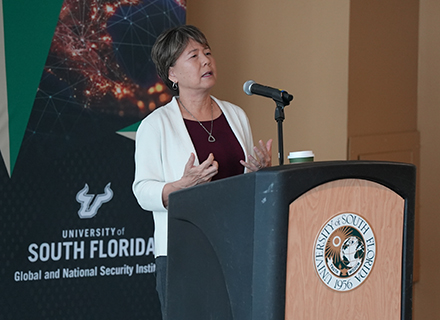
Tompkins addressing USF faculty, students and staff, September 29, 2023
Q: What’s the most important thing you’ll want those attending to remember from your speech?
The topic of ethics in emerging technologies is incredibly important. At DARPA, we have taken steps to build in considerations for ethical, legal, and societal implications (ELSI) throughout the program lifecycle (DevEthOps). What we’ve found is that when we follow a DevEthOps process, rather than slowing us down, it enables faster progress to a better solution aligned with the commander’s intent.
Q: Why do these types of events?
A: When I left the DC area a few years ago and moved to Colorado, I found myself surrounded by incredible innovators who, much to my dismay, were not familiar with DARPA and had not considered how their work could benefit national security. That experience led to the agency hosting a series of events last year around the country so that we could reach those pockets of creativity and innovation we might not otherwise get to know. As a follow up, we launched DARPAConnect, an effort that includes ongoing workshops, regional events, and coming soon, an online curriculum for engaging companies and academic institutions that have never worked with DARPA. Even at an institution like USF, which does work with defense and government, there are talented researchers who may not recognize the potential for their work to solve national security challenges. I often say that the thing that worries us the most is the person we never meet whose idea we don’t hear.
Q: Many have said the future of warfare is autonomous. Is that a good thing? Figuratively speaking, where is a good place for “the human to end and the machine to begin?”
A: As shared above, we are actively exploring the ethical, legal, and societal Implications (ELSI) of those technologies throughout our program development process, including for autonomous systems. Understanding the implications of success helps us provide information to the policy makers and government leaders who have to decide how technology should be used.
Q: How important is outside research to DARPA’s work? Specifically, what role does a premier research university like USF have in DARPA’s work?
A: Outside research is DARPA’s work. You are likely aware that DARPA does not have labs or facilities. DARPA program managers drive the research ideas and work closely with our performers, but all work takes place in our performer facilities – academic institutions, industry, and military service labs. It is an innovation ecosystem.
Q: From what academic areas do you most actively recruit? If a student is interested in pursuing a career with DARPA, what academic paths should they follow? Any other suggestions?
A: Similar to what I shared previously, the most significant breakthroughs often occur at the intersection of disciplines. So, we are always looking for people who spend time at such intersections, who are not afraid of risk, and want to change the world. For students, look for funded projects to work on, or for companies that have DARPA contracts, there’s nothing like being part of a DARPA project to expose you to the many ways you can work with us in the future.
Q: What attracted you to DARPA after your initial career in industry?
A: I was attracted by the mission and the culture. My career began with a US Army commission, which launched me on a career trajectory that almost always included some form of national service. As a scientist, I found DARPA offered an extraordinary opportunity to work at the intersection of technology and service, at a place filled with amazing people who are wholly committed to the agency mission.
The GNSI Tampa Summit 2 and DARPA 101 conversations served as a significant reminder of the pivotal role the Global and National Security Institute at USF can play in shaping the future of national security through cutting-edge research and collaboration. Tompkins' leadership and DARPA's mission continue to inspire the next generation of innovators and security experts. We encourage any USF researchers interested in working with DARPA to reach out to them through their DARPA Connect program.
